
A pawnbroker is an individual or business that offers secured loans to people, with items of personal property used as collateral. The items having been pawned to the broker are themselves called pledges or pawns, or simply the collateral. While many items can be pawned, pawnshops typically accept jewelry, musical instruments, home audio equipment, computers, video game systems, coins, gold, silver, televisions, cameras, power tools, firearms, and other relatively valuable items as collateral.

The Hong Kong Museum of Art (HKMoA) is the first and main art museum of Hong Kong, located in Salisbury Road, Tsim Sha Tsui. It is managed by the Leisure and Cultural Services Department of the Hong Kong Government. HKMoA has an art collection of over 17,000 items. Admission is free for permanent exhibitions. Its rival is the non-government-managed Hong Kong Arts Centre. These two museums are considered to be the top two art museums in Hong Kong that dictate the discourse of art in Hong Kong.

Helen Liang Memorial Secondary School (Shatin) (HLMSS, Chinese: 梁文燕紀念中學(沙田)) is a secondary school in Sha Tin, Hong Kong. The primary school division was founded in 1961, while the secondary school division was founded in 1977 and relocated to the current site of Sha Tin in 1988.

Kowloon Dairy Limited is a dairy producer in Hong Kong. It was established by George Ahwee and Rudy Choy in 1940.

The 2009 East Asian Games, officially known as the V East Asian Games, was an international multi-sport event that hosted by Hong Kong, China, between 5 December and 13 December 2009. A total of 2,377 athletes from 9 East Asian national competed in 262 events in 22 sports. It was the biggest sporting event ever held in the territory.
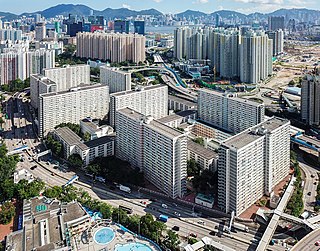
Choi Hung Estate is a public housing estate in Ngau Chi Wan, Kowloon, Hong Kong. It was built by the former Hong Kong Housing Authority (屋宇建設委員會) and is now managed by the current Hong Kong Housing Authority (香港房屋委員會). It received a Silver Medal at the 1965 Hong Kong Institute of Architects Annual Awards.

The Civil Human Rights Front (CHRF) was an organisation that focused on the issues of Hong Kong politics and livelihood, affiliated with almost all pan-democratic camps in Hong Kong. It was founded on 13 September 2002 and disbanded on 15 August 2021.
The Diocese of Western Kowloon is one of the three dioceses under the Hong Kong Sheng Kung Hui. Its territory covers most of western Kowloon and the western New Territories. All Saints' Church, then consecrated cathedral on 31 October 2010, was established in 1891, making it one of the oldest Anglican churches in Hong Kong. Incumbent bishop, Andrew Chan, was elected on 26 June 2011 and consecrated on 25 March 2012 to replace the outgoing bishop, Thomas Soo.
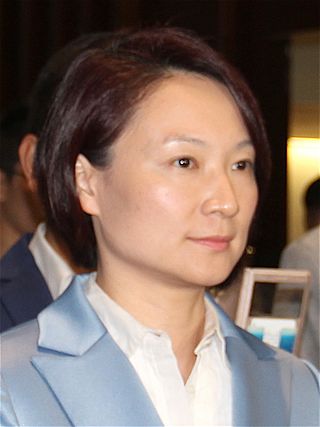
Starry Lee Wai-king, SBS, JP is a Hong Kong politician, chairperson of the largest pro-establishment Beijing-loyalist party, the Democratic Alliance for the Betterment and Progress of Hong Kong (DAB). She is a member of the Standing Committee of the National People's Congress (NPCSC), Legislative Councillor for the Kowloon Central geographical constituency, and a Kowloon City District Councillor. From 2012 to 2016, she was a member of the Executive Council.
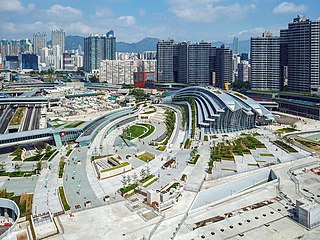
West Kowloon station, also known as Hong Kong West Kowloon, is the southern terminus of and the only station on the Hong Kong section of the Guangzhou–Shenzhen–Hong Kong Express Rail Link (XRL). The station connects to China's high-speed rail (HSR) network across the border through dedicated tunnels and includes a Mainland Port Area where the laws of (Mainland) China are enforced. It was constructed by the MTR Corporation Limited as the project manager commissioned by the Hong Kong Government, through subcontractors.

Guangzhou–Shenzhen–Hong Kong Express Rail Link (XRL), also known as “Guangshengang XRL”, is a high-speed railway line that connects Beijing and Hong Kong (Kowloon) via Guangzhou and Shenzhen.
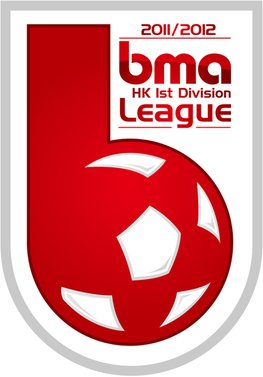
The 2011–12 Hong Kong First Division League, also known as 2011–12 bma Hong Kong First Division League season was the 100th since its establishment. Kitchee SC was the defending champions, having won their 4th Hong Kong title in the previous season.

Hong Kong Children's Hospital is the first children hospital in Hong Kong's public healthcare system, located in Kowloon City, Hong Kong. Located at the south apron of the former Kai Tak Airport, the hospital has 468 beds for inpatients and day-patients, providing mainly tertiary services for complex and rare paediatric cases. Funded by the Hong Kong Government, construction of the HK$13 billion hospital began in August 2013. The hospital treats patients with a referral up to 19 years of age.
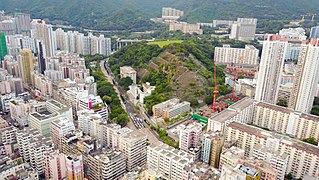
Garden Hill is a 300-foot-tall (90.6-metre) hill in the Sham Shui Po District in northwestern Kowloon, Hong Kong, near Un Chau, Om Yau and Pak Tin. Its summit is a popular place among photographers for its views of urban Hong Kong. One entrance to the trail leading to the summit can be found next to Grade II historic building Mei Ho House.

Hong Kong 12, or 12 Hongkongers, are the twelve Hong Kong protestors, previously arrested by the Hong Kong police, detained by the Chinese authorities in 2020 on sea after failed attempt to flee to Taiwan.

Nam Cheong Street is a street in Shek Kip Mei and Sham Shui Po, Sham Shui Po District, Kowloon, Hong Kong. It begins in the north at Lung Ping Road and Yan Ping Road in Shek Kip Mei and terminates in the south at Tung Chau Street and Boundary Street in Sham Shui Po.

Kowloon Central was a geographical constituencies in the election for the Legislative Council of Hong Kong in 1991, which elects two members of the Legislative Council using the dual-seat constituency dual vote system. The constituency covers Kowloon City District and Wong Tai Sin District in Kowloon.


















